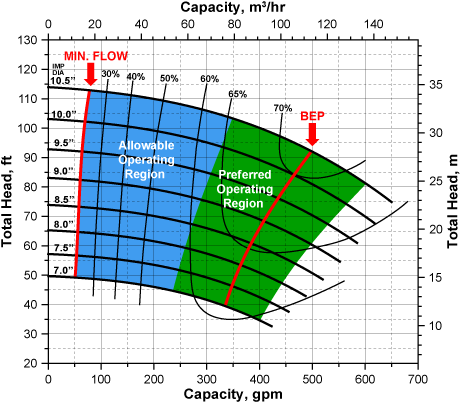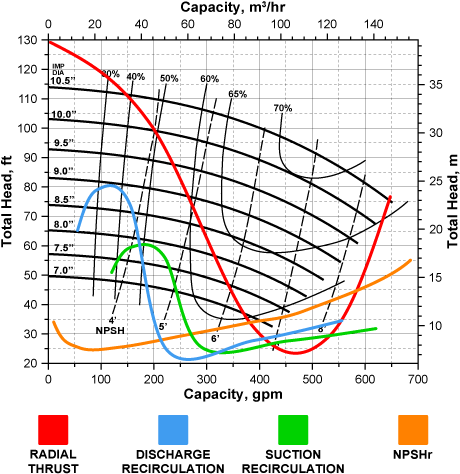Centrifugal pumps are kinetic devices that continuously impart energy to the fluid passing thru it, nominally designed around a desired flow and head point called the Best Efficiency Point (BEP). Since the BEP is a specific point, it is unlikely to find an application that exactly matches it. Therefore, guidelines exist to establish a preferred operating range (window) on either side of the BEP. For most situations the preferred operating range is between 70% and 110% of the BEP with an additional allowable range at low flow rates.

The contributing factors to these widely accepted limits include thermal limits, mechanical stress, flow recirculation and Net Positive Suction Head requirements.
Thermal Limits
The physical design of the impeller and casing, which are fixed in their design, achieve optimum efficiency at the BEP. As the pump operates away from this point, the efficiency drops as losses accrue. Most of this lost energy is converted to heat, which can become a significant issue close to no flow conditions. In particular, higher speed pumps of smaller size are particularly prone to very low or no flow conditions that rapidly increase the fluid temperature.
Mechanical Stress
In order to maintain a compact footprint, the majority of centrifugal pumps use a single volute design. While advantageous for size and therefore cost, the single volute design is naturally unbalanced in pressure development and therefore creates a net radial load on the rotating element. This net radial load or force increases significantly as the operating point deviates from the BEP.
Flow Recirculation
Fluid always follows the path of least resistance. When the pump is operating at the BEP, the fluid passes thru the impeller vanes with minimal disruption. As the operating point shifts to lower than design conditions, disruptions increase with areas of recirculation beginning within the impeller passages. In clean fluids, this condition may be tolerated. When solids are present, these pockets of recirculation accelerate wear and the impeller fails prematurely.
Net Positive Suction Head Required (NPSHr)
NPSHr is an oft misunderstood subject and deserves a discussion on its own (for a later post). In summary, it is the surplus pressure above the fluid’s vapor pressure required at the eye of the impeller to prevent cavitation. All centrifugal pumps have an NPSHr profile, which increases as more flow is pushed thru the pump, which is widely known and appreciated. What is less often reported or discussed is that NPSHr also increases significantly as the flow drops toward zero.
Low Flow

